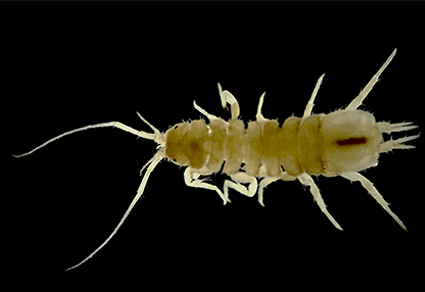Abstract
Caecidotea isabelae sp. nov., a new freshwater asellid isopod species from Jalisco, Mexico is described. During fieldwork in 2021, we discovered eight new populations of freshwater isopods belonging to the genus Caecidotea. One population corresponded to a new species, Caecidotea isabelae sp. nov., while the other seven populations were identified as Caecidotea alvarezi. These populations are reported from freshwater bodies on the western Trans-Mexican Volcanic Belt, expanding the distributional range of C. alvarezi through the state of Jalisco. The new species can be distinguished of their congeners mainly by the protopod of pleopod I triangular with 3 retinacula, exopod of pleopod III with 6 presutural setae, pleopod IV with 3 spines in the proximal external margin. The present study increases the number of known epigean asellid species in Mexico to 12, and the number of currently described Caecidotea species in North America to 102 with three subspecies.
References
- Argano, R. (1972) An asellid of the subterranean waters of Veracruz, Mexico (Crustacea, Isopoda). Accademia Nazionale dei Lincei Quaderno, 171, 35–42.
- Argano, R. (1977) Asellota del Messico meridionale e Guatemala (Crustacea, Isopoda). Accademia Nazionale dei Lincei, 171, 101–124.
- Barbour, C.D. (1973) A biogeographical history of Chirostoma (Pisces: Atherinidae): A species flock from the Mexican Plateau. Copeia, 3, 533–556. https://doi.org/10.2307/1443118
- Bowman, T.E. & Hobbs, H.H. (1983) Caecidotea filicispeluncae, a new troglobitic asellid isopod from Ohio. Proceedings of the Biological Society of Washington, 96, 693–697.
- Cole, G.A. & Minckley, W.L. (1968) A new species of aquatic isopod crustacean (genus Asellus) from the Puebla Plateau, central Mexico. Proceedings of the Biological Society of Washington, 81, 755–760.
- Comisión Nacional para el Conocimiento y Uso de la Biodiversidad (CONABIO). (2023) Geoinformation Portal, National Biodiversity Information System. Available from: http://www.conabio.gob.mx/informacion/gis/?vns=gis_root/hidro/chidro/cue250kgw (accessed 10 July 2023)
- Comisión Nacional del Agua (CONAGUA). (2023) Actualización de la disponibilidad media anual de agua en el acuífero Tapalpa (1421), Estado de Jalisco. Available from: https://sigagis.conagua.gob.mx/gas1/Edos_Acuiferos_18/jalisco/DR_1421.pdf (accessed 18 January 2024)
- Conant, R. (2003) Observations on Garter Snakes of the Thamnophis eques Complex in the Lakes of Mexico’s Transvolcanic Belt, with Descriptions of New Taxa. American Museum Novitates, 3406, 1–64. https://doi.org/10.1206/0003-0082(2003)406<0001:OOGSOT>2.0.CO;2
- Doadrio, I. & Domínguez, O. (2004) Phylogenetic relationships within the fish family Goodeidae based on cytochrome b sequence data. Molecular Phylogenetics and Evolution, 31 (2), 416–430. https://doi.org/10.1016/j.ympev.2003.08.022
- Erosas-Elguera, J. & Urrutia-Fucugauchi, J. (1998) Tectonic control of the volcano-sedimentary sequence of the Chapala Graben, Western Mexico. International Geology Review, 40, 350–362. https://doi.org/10.1080/00206819809465214
- Escobar-Briones E. & Alcocer, J. (2002) Caecidotea williamsi (Crustacea: Isopoda: Asellidae), a new species from a saline crater-lake in the eastern Mexican plateau. Hydrobiologia, 477, 93–105. https://doi.org/10.1023/A:1021013132626
- García-Vázquez, L., Rodríguez-Almaraz, G. & Pedraza-Lara, C. (2019) Caecidotea camaxtli (Isopoda: Asellidae) a new species from the Tlaxcala valley, Mexico. Zootaxa, 4624 (3), 377–386. https://doi.org/10.11646/zootaxa.4624.3.6
- García-Vázquez, L. (2020) Revisión taxonómica de las especies epigeas del género Caecidotea Packard, 1871 (Crustacea: Isopoda: Asellidae) de la región Central de México. PhD thesis. Universidad Autónoma de Nuevo León, Ciudad Universitaria, San Nicolás de los Garza, Nuevo León, 488 pp. https://doi.org/10.13140/RG.2.2.29417.83048
- García-Vázquez, L., Pedraza-Lara, C. & Rodríguez-Almaraz, G.A. (2021) Six new epigean species of Caecidotea (Isopoda: Asellidae) distributed along the Trans-Mexican Volcanic Belt in Central Mexico. Zootaxa, 4965 (1), 45–77. https://doi.org/10.11646/zootaxa.4965.1.2
- García-Vázquez, L., Campos, G. E. & Rodríguez-Almaraz, G.A. (2023) A new and rare epigean asellid from western Mexico Caecidotea contrerasbalderasi sp. nov. (Isopoda: Asellidae) with a new suture pattern in pleopod IV for the Mexican epigean species. Nauplius, 31 (e2023012), 1–10. https://doi.org/10.1590/2358-2936e2023012
- García-Vázquez, L., Alvarado-Ortega, J. & Vega, F.J. (2023) Pliocene freshwater isopods (Crustacea: Peracarida: Isopoda) from Jalisco, Mexico: Boletín de la Sociedad Geológica Mexicana, 75 (1), A271122. https://doi.org/10.18268/BSGM2023v75n1a271122
- Israde, I., Velázquez-Durán, R., Lozano, M., Bischoff, J., Domínguez, G. & Garduño, V. (2010) Evolución paleolimnológica del Lago Cuitzeo, Michoacán durante el Pleistoceno-Holoceno. Boletín de la Sociedad Geológica Mexicana, 62 (3), 345–357. https://doi.org/10.18268/BSGM2010v62n3a3
- Lewis, J.J. & Bowman, T.E. (1981) The subterranean asellids (Caecidotea) of Illinois (Crustacea: Isopoda: Asellidae). Smithsonian Contributions to Zoology, 335, 1–66. https://doi.org/10.5479/si.00810282.335
- Lewis, J.J. (2009) Three new species of Caecidotea, with a synopsis of the asellids of Virginia (Crustacea: Isopoda: Asellidae). In: Roble, S.M. & Mitchell, J.C. (Eds.), A lifetime of contributions to Myriapodology and the natural history of Virginia: A festschrift in honor of Richard L. Hoffman’s 80th birthday. Virginia Museum of Natural History Special Publication No. 16. Virginia Museum of Natural History Martinsville, Virginia, pp. 251–266.
- Lewis, J.J (2015) The subterranean asellids of Indiana (Isopoda), with the description of Caecidotea dunlaporum, new species. Journal of Cave and Karst Studies, 77 (2), 99–107. https://doi.org/10.4311/2014LSC0111
- Pedraza-Lara, C., Doadrio, I., Breinholt, J. & Crandall, K. (2012) Phylogeny and evolutionary patterns in the dwarf crayfish subfamily (Decapoda: Cambarellinae). PLoS One, 7 (e48233), 1–18. https://doi.org/10.1371/journal.pone.0048233
- Rocha-Ramírez A. & Peñaloza-Daniel, A. (2011) Caecidotea xochimilca (Isopoda, Asellidae), a new species from lake Xochimilco, Mexico, with a key to Mexican species of the genus Caecidotea. Crustaceana, 84 (1), 93–106. https://doi.org/10.1163/001121610X546715
- Sigala, I., Caballero, M., Correa, M.A., Lozano, G.S., Vázquez, G., Pérez, L. & Zawisza, E. (2017) Basic limnology of 30 continental waterbodies of the Transmexican Volcanic Belt across climatic and environmental gradients. Boletín de la Sociedad Geológica Mexicana, 69 (2), 313–370. https://doi.org/10.18268/bsgm2017v69n2a3
- Shorthouse, D.P. (2010) SimpleMappr, an online tool to produce publication-quality point maps. Available from: http://www.simplemappr.net (accessed 23 September 2022)
- Toft, J.D., Cordell, J.R. & Fields, W.C. (2002) New Records of Crustaceans (Amphipoda, Isopoda) in the Sacramento/San Joaquin Delta, California, and Application of Criteria for Introduced Species. Journal of Crustacean Biology, 22 (1), 190–200. https://doi.org/10.1651/0278- 0372(2002)022[0190:NROCAI]2.0.CO;2
- Williams, W.D. (1970) A revision of North American epigean species of Asellus (Crustacea: Isopoda). Smithsonian Contributions to Zoology, 49, 1–79. https://doi.org/10.5479/si.00810282.49


